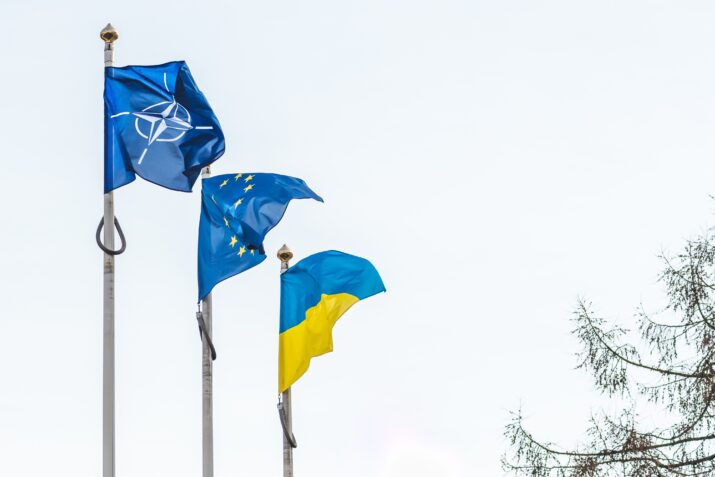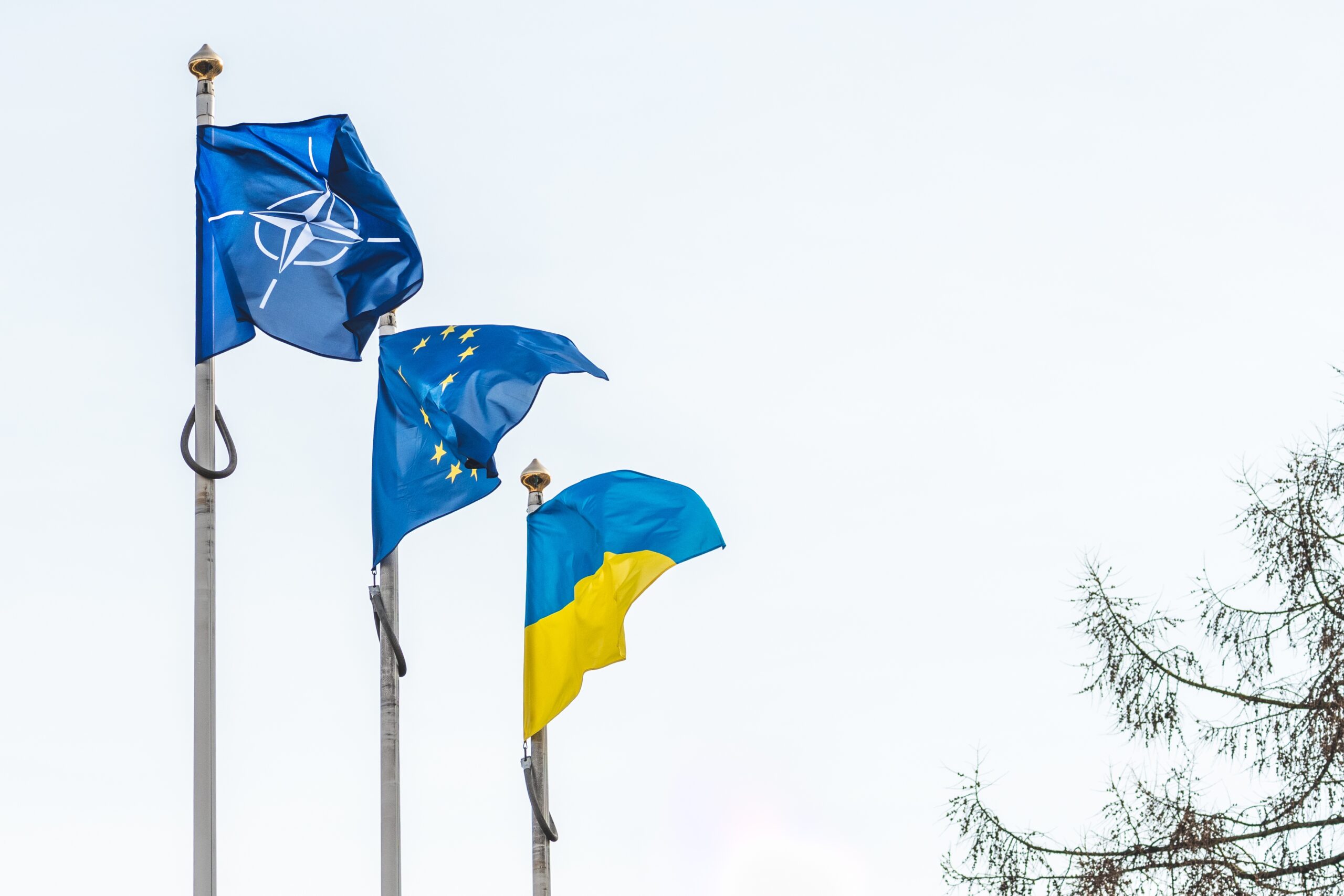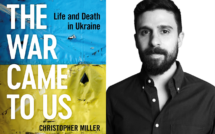

This is part of our special feature, Europe and NATO Since Ukraine.
Echoes of war tend to reverberate for a long time in international relations since at the moment hostilities end, it is often too early to predict the precise implications of the war. Therefore, the question about the impact of the Ukraine war on the transatlantic relationship and Euro-Atlantic institutions (EU and NATO) can be only conditionally answered at this time. Despite this caveat, I argue that surprisingly the EU has been able to maintain unity during the war. At the same time, the European Commission’s strong showing in foreign policy (“external relations” in EU-speak) has been unprecedented; and American leadership has proven to be “indispensable” in forging political unity among European NATO allies again.
The immediate effects of the Russian invasion
To most national capitals on both sides of the Atlantic, Russia’s invasion of Ukraine did not come as a complete surprise; but it was hoped that diplomacy would turn the tide or at least would buy time to appease Russian president Vladimir Putin. During the run-up to the war, initiatives by European leaders—particularly French leaders[1]—failed, however, to reverse Russia’s plans. Various intelligence services differed in their assessment of the upcoming attack’s timing. Whereas some continental European intelligence services even doubted Russia would go to war at all, their British and American counterparts had fewer doubts about Putin’s intentions. In the end, the latter proved to be right in forecasting the massive Russian attack on 24 February 2022.[2]
Russia’s invasion of Ukraine sparked a number of consequences in European international affairs. Some of these consequences were clearly unintended—at least, from the Russian point of view. Finland’s and possibly Sweden’s NATO membership are among the most obvious examples. Additionally, Ukraine’s full EU membership seemed to be fast-tracked. Other outcomes were more predictable. Almost inevitably, the crisis in Ukraine resulted in increased tensions between the West and Russia and brought about a confrontational, anti-Kremlin mood in the transatlantic community. Therefore, the numerous Western sanctions could hardly have come as a surprise to Moscow.
Some European countries suffered more than others due to the self-imposed sanctions on energy provision, travel, Russian assets, and business relationships and due to the changed relationship with Russia. Arguably, Germany was impacted more than other EU member states by the Ukraine war, which led to the “Zeitenwende,” a drastic reform of Germany’s foreign and economic relationship with Russia. Radical measures were taken. For example, Germany cut itself off voluntarily from Russia’s gas supply and trade. The German chancellor Olaf Scholz further announced an unprecedented major investment in the neglected German military forces to boost German and thus European military capabilities. The lack of political support from the non-Western world for the Western coalition against Russia illustrated the changed global strategic landscape in this century. Today, the Global South no longer feels the need to follow Western-style political leadership and direction.
Transatlantic fragmentation
Whether this new global order will become multipolar, partly unipolar, or a Chinese order remains to be seen.[3] The same uncertainty prevails regarding the direction and character of the transatlantic relationship as it has developed since the end of the Cold War. There are numerous narratives in circulation about European-American relations since then.[4] This much is clear: at the turn of the century the transatlantic relationship—a dense network of political, economic, and cultural factors—became increasingly politically fragmented. Differences on issues of values and threat perceptions became clearly visible too, in particular after the Iraq war in 2003, when the relationship reached its lowest point. Political divisions certainly existed not only across the Atlantic but within Europe as well, as captured by the opposition between the “Old” and the “New” Europe.
Visible divergences continued under President Obama. His strategy towards a “pivot to Asia” was not well understood in Europe—nor was it in the US.[5] The European-perceived “noise” on the European-American line regarding the Middle East and the Syrian civil war in particular was a corollary of this “pivot.” On the American side, at least three main political grievances played a role. First, Germany’s energy policy—based on the Nord Stream energy pipelines—resulted in high level of energy dependency on Russia. Second, Angela Merkel’s accommodation policy towards Russia in fact continued her predecessor’s special relationship with Moscow. Third, NATO’s European members were unable—or unwilling—to meet the ”two percent standard” for defense expenditures pledged at the 2014 NATO summit. This particular issue caused considerable resentment on the American side. The question arises as to how the deeply entrenched culture of dependency of European NATO members on the US can end and enable the US to divert its resources elsewhere in the world.
All these factors came together when President Trump took office. In his “America First,” he expressed a completely new—almost nationalistic—sound for the Europeans and referred to NATO, in his typically blunt way, as “obsolete” and “as bad as NAFTA.”[6] European leaders found it very difficult to understand Donald Trump’s strategic outlook or to connect with him. On balance, however, Trump’s tenure was less destructive for NATO than often assumed. Via “subtle strategies of coalition-building,” NATO’s Secretary-General Jens Stoltenberg managed to take the sting out of Trump’s often puzzling demands. Stoltenberg was able to put an end to Trump’s most dangerous desire, i.e., a closer bond with Russia. Stoltenberg was also able to exploit the burden-sharing issue—one of Trump’s other grievances—to the advantage of NATO as a whole, urging its members to finally invest more resources in defense.[7]
The Biden Administration, arguably the most pro-Atlanticist administration in this century, wanted a fresh start. But these intentions were immediately thwarted by the COVID-19 pandemic, which set off a series of national policies across the Atlantic. Coordination between the centralized approach of the European Commission and the White House in combating the pandemic was clearly absent. Besides, US foreign policy continued to be focused on China, which was still seen by both political parties as America’s main global competitor.
Impact of the war on the EU
The war in Ukraine has deeply impacted the EU, in both an economic and political sense. Economically, the energy dependence on Russia, anticipated by so many, came to an abrupt end, driving inflation to startling heights.[8] Just as important is the fact that the European Council surprisingly succeeded in closing ranks during the many meetings it held after the beginning of the war. After all, when it comes to strategic issues, European politics have generally been marked by strong divisions of opinions. Political geography, more than values, tends to determine the national thinking and views of the European member states. Even the notorious trouble-maker Hungary found it difficult to distance itself from the EU’s official positions condemning Russia, although it did not hesitate to send ambivalent, pro-Russian messages outside the European institutions.[9]
When she entered office in 2019, the President of the European Commission, Ursula von der Leyen, proposed to transform the commission into a geopolitical commission. She soon put her words into action. Using her savvy public relations style, she sought an answer to America’s reprioritization of foreign policy towards the Indo-Pacific. The French-coined notion of “strategic autonomy” became the buzzword, although it was acknowledged in the EU’s The Strategic Compass of the EU (March 2022) that strategic autonomy continues to have a divisive meaning among European capitals.[10] As so often, the opinions about the goals, ways, and means of a common policy varied greatly among the EU members, while the EU’s foreign policy “chief” had little decision-making leverage to unite the national capitals. Von der Leyen’s commitment to Ukraine was unparalleled, however. This commitment manifested itself when the question of Ukraine’s (aspirant) membership came on the table. In an unprecedented Alleingang for a President of the European Commission, she rushed to Kyiv to assure President Zelensky of her support for a fast-track EU membership for Ukraine, saying that “Ukraine is one of us and we want them in EU” and pushing her mandate to the limits. That in the end her action found little resonance in the European Council was clearly demonstrated by the usual political bickering among the member states during the Council meeting in October 2023. The vast majority of EU members responded negatively to the European Council President Josep Borrell, who proposed a rapid enlargement process or an exception for Ukraine.
Despite the European Council’s discontent about von der Leyen’s action at the beginning of the war, the European Commission further built on a centralized approach during the pandemic and expanded it to the security domain. Thus, the Commission was able to agree on common funding for arms and ammunition, financing purchases directly or enabling arms deliveries from the member states’ stockpiles. All these initiatives have also remained in line with the European Commission’s policy of seizing the advantages of economies of scale for a stronger European defense market.
As a consequence, the EU has developed into the largest (non-military) financial contributor of aid to Ukraine. Collectively, the EU has committed approximately $38 billion in military support to Kyiv. The US’s closest European ally, the UK, has donated approximately $9 billion in direct military aid alone. France has been relatively in the rear as an arms contributor, channeling its support mainly through European institutions. Notwithstanding the Commission’s efforts, the US has been the largest provider of military aid to Ukraine to date, with approximately $47 billion in contributions.[11]
American leadership in NATO in the face of the Ukraine war
In a major study—Strategic Vision (2012)—Zbigniew Brzezinsky argued that Ukraine is among the geopolitically most endangered states in the world. According to Brzezinsky, without US support, Ukraine could soon turn into another of Russia’s vassal states, and Russia could then debilitate NATO and the EU through political influence. This thesis is apparently a lesson well remembered by American policymakers because the US took the lead in resisting Russia’s aggression immediately after the war started. The US succeeded in forging a coalition of like-minded Western countries—the so-called Ukraine Defense Contact Group. Also known as the “Ramstein group,” this coalition consists of approximately 50 countries—including some from outside Europe—that have donated military equipment to support Ukraine’s war efforts.
Another indication of US leadership has been the US’s ability to convince Germany to change course regarding the important issue of sending to Ukraine heavy weaponry such as such as tanks, artillery, anti-aircraft missiles, etc. Rather than the EU, it is the US that led this effort. In other words, the Berlin-Washington axis saw something of a modest revival, although “close coordination” might be a more appropriate description. America’s leadership became most visible in NATO, which is the main organization in Europe for carrying out common transatlantic security policies. The US succeeded in implementing a number of its strategic objectives in NATO: a common front against Russia, an increased deterrence policy, and increased European defense capabilities.
Immediately after Russia’s full-scale attack, NATO made it clear that Russia had crossed a red line. NATO allies instantly increased weapons deliveries to Ukraine. In addition, NATO reinforced its defensive posture on the entire eastern flank, which meant activating NATO’s Response Force (NRF, July 2003) for the first time ever, with French military deployed at the forefront in Romania. In addition, the existing deterrence and defense doctrines were quickly adopted at NATO summits in Madrid (July 2022) and Vilnius (July 2023). The three core tasks of NATO—deterrence, collective defense, and crisis management—remained unchanged, but the accents definitely shifted further away from crisis management to deterrence and defense. An increasingly “Cold War-style” regional division of labor in the alliance would be implemented again in Northern, Central, and Southern Europe, respectively. At the Madrid summit, the Allies agreed on a new “Force Model,” in which the 40,000-strong NRF would be replaced by the Allied Reaction Force (ARF). At the Vilnius summit, it was decided that different levels of military readiness would be used for acute crises within a short time span. The number of these forces would range from “tier 1” to “tier 3” and reach as high as 500,000. These robust force projections were aimed at strengthening deterrence and defense credibility.[12]
Before the Madrid summit, the political desirability of Ukraine’s membership in NATO had arisen at the Bucharest summit of 2008, when a huge divide emerged between American and Franco-German strategic thinking. At the time, due to European opposition, the US failed to instantly put Ukraine on a formal track toward full membership in the Alliance. Upon the invasion, once more, the issue of Ukraine’s membership in NATO became impossible to ignore. It became clear quickly, however, that granting full membership to Ukraine during the war was out of the question. The risk of invoking “Article 5”—the so-called “solidarity clause” that commits all members to defend any member under attack—in a situation involving Russia was considered too high. The NATO Vilnius summit therefore adopted the same ambiguous language used at the 2008 NATO summit in Bucharest, i.e., that Ukraine “will become a member of NATO.” The only commitment made to Ukraine by NATO was to delete the pre-entry Membership Action Plan requirement.
In line with NATO’s new force requirements, which entail additional deployments of battle groups and the scaling up of battle groups to brigade level where and when necessary, NATO’s “under-spenders” finally changed course and announced robust defense investment plans. Germany, in particular, seemed to have shaken off its “war guilt” towards Russia and confirmed its intention to increase its military capabilities. As briefly noted earlier, major decisions in Germany about the delivery of heavy arms were, however, not taken without involving the US, for example in the case of the delivery of German heavy tanks (Leopard 2) to Ukraine. Only on condition that the US was to deliver its own heavy tanks (M1 Abrams) did Bundeskanzler Scholz agree to hand over Leopard 2 tanks to Ukraine’s army. In this sense, Germany has continued its cautious approach to foreign policy, seemingly taking cover behind others.
Another remarkable aspect of US leadership in NATO concerns the lack of dissenting opinions among the European NATO Allies. Viktor Orbán, Hungary’s Prime Minister, is the prominent leader of the revisionist voice within the EU about accommodating Russia. By contrast, Hungary’s position in NATO never makes press headlines, whereas in the European Council Orbán is able to draw blood from European peers. Likewise, another potentially dissenting ally—Turkey—has apparently complied with the organization’s current discipline, while not unequivocally supporting Ukraine. The US’s role as NATO’s leader has undoubtedly made a fundamental difference, and the US offering F-16s to Turkey as some form of compensation has helped.
Still, in November 2019, French President Macron gave a now famous interview to The Economist (7 November 2019), in which he observed the coming “brain death” of NATO and speculated that European allies could no longer rely on America for their defense. NATO’s Article 5, he said, may tomorrow be meaningless. While the French approach to European security has been consistent, insisting on the EU as the main framework for European security, so far the Ukraine war has not split NATO’s ranks.[13]
The unbalanced transatlantic partnership
In 1990, then NATO Secretary-General Manfred Wörner argued that “The Atlantic Alliance has an interest in a stronger and more united Europe—going all the way to political union, including a European defence identity within the broader Atlantic framework.” [14] The reality seems, however, that after so many years the transatlantic relationship is still an unequal partnership. Economically, Europe has indeed caught up. But the “appalling”[15] state of defense—another layer in the transatlantic relationship—presents a greatly different picture. As NATO Secretary-General Stoltenberg put it sharply in Bruges in March 2021: “The EU cannot defend Europe.”
Unlike the European political union Wörner had in mind, the EU currently lacks any unity in its political direction and decision-making power. Paying lip service to common policies results in watery, sometimes nonsensical, compromises. Despite these caveats, the Ukraine crisis has had the effect of a “wake-up call,” requiring resilience and the unification of the Union in strongly condemning Russia and outpouring political and military support for Ukraine. The greater question is whether this determined attitude is a one-time affair. Or does this commitment have the potential to further develop into a more unifying stance in EU foreign policy, including through the development of (future) military capabilities, notwithstanding the huge costs of such policies?
In the Ukraine crisis, US leadership has shown to be of the upmost importance once again in forging political unity among the European allies. In the foreseeable future, political and military imbalances might inevitably prevail in the transatlantic relationship.[16] This reality is difficult to swallow for European advocates of “strategic autonomy.” Should American support, in particular the American security umbrella, come to an end, European leaders may then be forced to revive some form of special relationship with Russia—ironically the only country currently demonstrating “strategic autonomy” in practice—in the absence of credible alternatives.
It is therefore disappointing but safe to conclude that by no means can Europe follow in America’s footsteps in defending Ukraine. European leaders admitted this state of affairs themselves on 4 October 2023 when, in response to President Biden’s difficulties in getting Congress to agree on funding for Ukraine, they stated they would be unable to provide funding to make up for the lesser American contributions. Therefore, the historic unbalance among the Atlantic partners—Europe and North America—likely will not come to an end any time soon.[17]
Abraham (“Bram”) Boxhoorn is currently Assistant Professor of International Relations and History at Webster University, Leiden Campus. His fields of specialization are the history of European international relations and transatlantic studies. His latest publication is a book co-authored with Giles Scott-Smith, entitled The Transatlantic Era (1989–2020) in Documents and Speeches (Routledge, 2022).
[1] See the documentary, A President, Europe and War [original title: Un Président, l’Europe et la guerre], (Production Elephant et al., 2022).
[2] “… it would be unfair to say Western estimates of the chances of Ukrainian resistance constitute an intelligence failure. This is the paradox of intelligence warning: if analysts warn of a dire event, and this prompts state action which averts it, was the initial estimate wrong? No. The differences in intelligence assessments from Ukraine and various NATO allies highlight the precarious nature of strategic warning.” Quoted from Intelligence and the war in Ukraine, Part I, Neveen Abdalla et al., in: Texas National Security Review, (May 11, 2022), retrieved 17 October 2023 ( https://warontherocks.com/2022/05/intelligence-and-the-war-in-ukraine-part-1/)
[3] The most recent debate, see Joshua Shifrinson et al., The Long Unipolar Moment? Debating American Dominance, in: Foreign Affairs, October 17, 2023. Retrieved 17 October, 2023. (https://www.foreignaffairs.com/responses/long-unipolar-moment)
[4] For the most recent overview of the historiography on transatlantic relations, see chapter 1 of The Transatlantic Era (1989-2020) In Documents and Speeches, edited by Bram Boxhoorn and Giles Scott-Smith (Routledge 2022).
[5] For this, The Pivot to Asia Was Obama’s Biggest Mistake, by John Ford, in The Diplomat (January 21, 2017). Retrieved on 17 October, 2023 (https://thediplomat.com/2017/01/the-pivot-to-asia-was-obamas-biggest-mistake/)
[6] Quoted from ‘NATO in the Age of Trump. What It Can and Can’t Accomplish Absent U.S. Leadership’, in Foreign Affairs, July 2018
[7] Leonard Schütte, “Why NATO survived Trump: the neglected role of Secretary-General Stoltenberg, “ International Affairs, 97:6 (November. 2021), pp. 1863-1881.
[8] A separate but relevant issue in this context concerns the blast of the Nord Stream pipelines, “Intelligence Suggests Pro-Ukrainian Group Sabotaged Pipelines, U.S. Officials Say,” The New York Times, 7 March, 2023.
[9] As Politico (15 September 2022) has put it quite correctly: “Hungary’s ambivalent stance is the inevitable result of a combination of domestic political influences, as well as its complex relationships with Russia, Ukraine and the West.” Retrieved 24 October, 2023. (https://www.politico.eu/article/hungary-pro-russia-stance-inevitable/).
[10] https://www.strategic-compass-european-union.com/ (quoted in the section: Addressing the Strategic Challenges)
[11] https://www.ifw-kiel.de/topics/war-against-ukraine/ukraine-support-tracker/ Retrieved 24 October, 2023.
[12] For a thorough analysis of “Vilnius,” see Dick Zandzee, ” NATO’s Vilnius summit: the consequences for the Allies,” Atlantisch Perspectief 2023:3, pp.20-24
[13] The intellectual flexibility of French strategic thinking is sometimes unsurpassable, see e.g. Roland Freudenstein’s comments on President Macron’s speech in Bratislava, https://kyivindependent.com/roland-freudenstein-macrons-bratislava-speech-a-french-zeitenwende-or-charm-offensive/. Retrieved 25 October, 2023.
[14] https://www.nato.int/docu/speech/1990/s900517a_e.htm
[15] Max Bergmann and Sophia Besch, “Why European Defense Still Depends on America,” Foreign Affairs, March 7, 2023. Retrieved 17 October, 2023. (https://www.foreignaffairs.com/ukraine/why-european-defense-still-depends-america)
[16] For a somewhat more optimistic view, see Matthias Matthijs and Sophie Meunier, “Europe’s Geoeconomic Revolution. How the EU Learned to Wield Its Real Power,” Foreign Affairs, September/October 2023. https://www.foreignaffairs.com/europe/european-union-geoeconomic-revolution, Retrieved 29 October, 2023.
[17] “European leaders say they can’t fully replace U.S. support to Ukraine as funding fears grow,” CNBC, October 5, 2023. https://www.cnbc.com/2023/10/05/russia-war-eu-says-europe-cannot-replace-us-support-to-ukraine.html. Retrieved 24 October, 2023.
Published on February 15, 2024.




